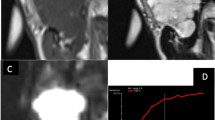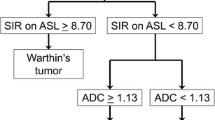Abstract
The diagnostic value of 3D T2-weighted MRI sialography and 2D T2-weighted fast spin-echo (FSE) images for delineation of the normal duct system and characterisation of parotid gland duct pathology was compared in a prospective study. We studied eight healthy volunteers and 18 patients with pathology of the parotid gland (tumours in 3, sialolithiasis in 6, Sjögren's disease in 4, recurrent or chronic parotitis in 4, post-traumatic stricture of the main parotid duct in 1). A heavily T2-weighted 3D FSE sequence was compared with a conventional 2D T2-weighted FSE sequence. The normal main parotid duct was always visible on 3D sialography and seen in 68 % of the 2D T2-weighted FSE studies. The diagnostic reliability of both sequences for diagnosis of luminal concretions in sialolithiasis and dilatation of the duct in duct stricture or chronic parotitis was equal, although slight intraglandular dilatation was appreciated only on 3D sialography. Extraductal pathology resulting in obstruction or displacement of ducts was better characterised on 2D T2-weighted images. However, 3D MRI sialography offered the advantage of postprocessing with overview images and multiple maximum-intensity projection images in any plane.
Similar content being viewed by others
Author information
Authors and Affiliations
Additional information
Received: 29 January 1998 Accepted: 15 May 1998
Rights and permissions
About this article
Cite this article
Sartoretti-Schefer, S., Kollias, S., Wichmann, W. et al. 3D T2-weighted fast spin-echo MRI sialography of the parotid gland. Neuroradiology 41, 46–51 (1999). https://doi.org/10.1007/s002340050704
Issue Date:
DOI: https://doi.org/10.1007/s002340050704




